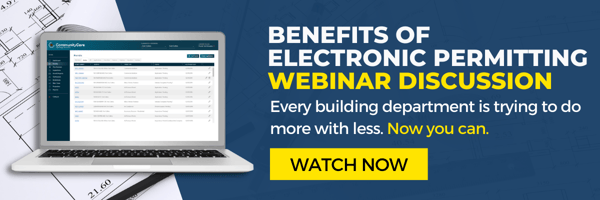Waiting at a window for a permit in a dusty government office during business hours is becoming a thing of the past–and for many businesspeople it’s long overdue. The business process of permitting is increasingly moving online, spurred on by demands from citizens who want governments to adopt some of the simplified online interactions now common in the business world.
Whether it’s on the federal level with the Environmental Protection Agency or the Department of Housing and Urban Development, on the state level with transportation, or on the city level with building permits, governments are developing systems of e-permitting that provide better customer service, are more efficient, and save money, space, and time.
Examples of tasks that can be performed electronically, according to HUD’s Electronic Permitting Systems and How to Implement Them, include:
- plan review
- permitting
- inspections
- inspection scheduling
- project tracking
- fee calculation and collection
- workflow management
- customer communications through web-based customer services
- telephone-based voice response services
- inter- and intra-departmental communication and management
The extremely detailed 60-page report explains the advantages of such systems, as well as case studies about communities of various sizes and how they have implemented them. Although the report dates from 2002, its basic principles still apply, even though some of the vendor information is out of date. For example, it includes a long list of benefits to electronic permitting, such as:
- standardized building site information
- improved record keeping and reliable archiving of permitting activities
- enhanced communication between customer and staff that produces higher quality plan submissions and reviews, permit applications, and customer service
- defined workflow and project tracking that reviews plans and approves permits more quickly
- higher quality inspections with better scheduling and improved reporting
- more efficient use of staff time and less duplication of effort
- better internal management tools for gauging department efficiency and spotting problems
- improved financial tracking of permitting, plan review, and inspection fees
- flexible reporting capabilities that document the volume of work completed and the revenue generated by the department
In addition, notes the EPA in its 2001 report, Electronic Permitting in U.S. EPA’s Delegated Programs: A Review of an Emerging Landscape, an open permitting process is more likely to increase citizen satisfaction in government transparency. “[O]ther public users, including public agencies with an interest in permitting decisions, now obtain information regarding status of application and hearings; hence public satisfaction has generally grown as the public feels the process is more transparent,” the department writes. “Such public expectations for timely information must be met in the future.”
In fact, even smaller cities and towns are starting to jump on the e-permitting bandwagon. Massachusetts, for example, provided a total of $112,000 in grants to nine towns to implement e-permitting. The town of Upton, one of the recipients, told the Milford Daily News that e-permitting would help the town be more efficient with the same number of staff, and would enable citizens to get building permits without having to go to City Hall.
Portland, Maine, recently announced its intention to implement an e-permitting system as part of its goal of streamlining the permitting process for developers. “Other steps the city proposes to implement in the coming months to streamline permitting and inspections include the launch of an electronic plan review system, in which city reviewers and regulators can access plans remotely and simultaneously, instead of by passing around paper copies from office-to-office,” writes the Bangor Daily News. “The electronic system will also feature components accessible from mobile devices, so inspectors can enter data and complete reviews at the sites of the proposed projects, without waiting to return to their offices to fill out additional paperwork.”
Mesa County, Colo., has implemented an e-permitting system for builders that frees them from having to spend valuable daylight building hours dealing with permits. “This new process allows the applicant to submit an application on line without assembling and submitting numerous packets of information for review,” the county describes. “The process also allows the applicant to view the progress of the application in real time – any time of the day or night – using the internet. The applicant can communicate with the staff planner and the review agencies during the process using the internet program, by e-mail, by telephone or in person.”
And in California, Sonoma County is developing an e-permitting system specifically for solar power permits. “Based on current permit volume in Sonoma County, online permitting would save an estimated $800,000 annually just from eliminating the need to scan and file paper applications,” the county told the North Bay Business Journal.


